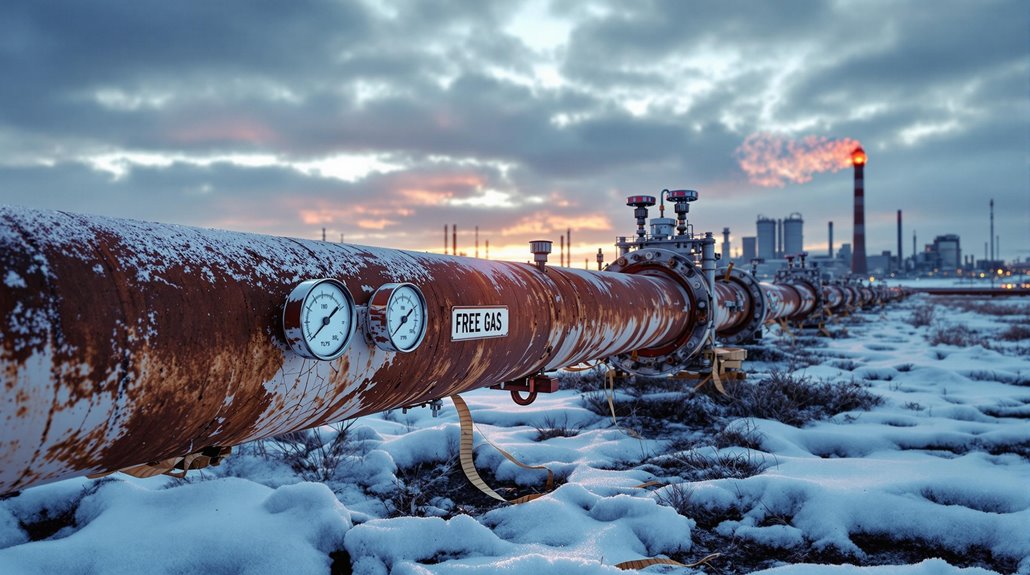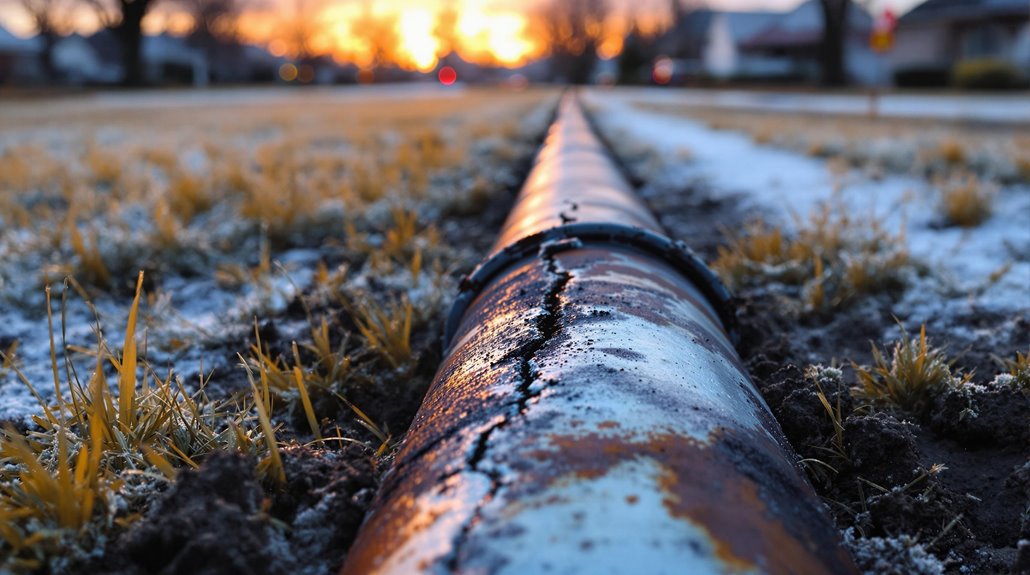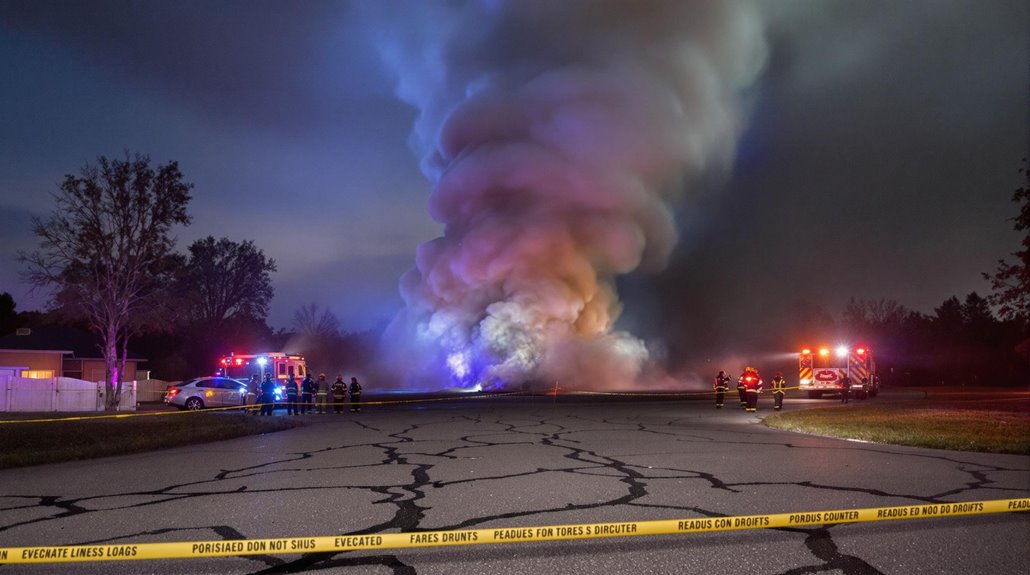What Are the Potential Risks Associated With the Natural Gas Grid?

Natural gas infrastructure exposes you to multiple serious risks, from aging pipelines prone to dangerous leaks and explosions to widespread system failures during extreme weather. You'll face threats from methane emissions damaging the environment, while interconnected electrical grid dependencies can trigger cascading outages affecting entire regions. In urban areas, you're particularly vulnerable to safety hazards from pipeline accidents. Understanding these complex challenges will help you grasp the full scope of our energy system's vulnerabilities.
Infrastructure Vulnerabilities and Aging Systems
How vulnerable is America's aging natural gas infrastructure? You're facing significant risks from deteriorating Natural Gas Pipelines that have been in service for decades. The gas transmission system is increasingly susceptible to failures due to corrosion, material defects, and ground movement stresses that compromise pipeline integrity.
When you consider that much of this infrastructure hasn't been adequately maintained or upgraded, the threat of leaks and explosions becomes even more concerning. What's particularly troubling is how these aging systems connect to the power system, creating a dangerous domino effect during disruptions. If one system fails, it can trigger widespread outages in both gas and electricity services.
Extreme weather events further strain these vulnerable networks, potentially leading to catastrophic failures that affect your safety and disrupt essential services. With components averaging 40-50 years old, these aging systems represent a critical vulnerability in our nation's energy infrastructure.
Environmental Impact on Local Ecosystems
Beyond infrastructure safety concerns, natural gas pipelines pose serious threats to your local environment and ecosystems. When companies build and operate natural gas pipeline systems, they create lasting environmental impacts that affect your community's natural resources. You'll find that pipeline construction fragments forests, disrupts wildlife habitats, and enables invasive species to spread. The infrastructure also increases stormwater runoff and degrades water quality in nearby streams through heightened sediment levels.
The environmental damage doesn't stop there. Methane leaks from these systems contribute to air pollution and accelerate climate change. When companies clear vegetation for pipeline corridors, they're reducing nature's ability to filter air, clean water, and store carbon. Worse yet, potential accidents can contaminate your soil and groundwater, threatening the survival of local plant and animal species. This environmental disruption can severely impact urban foraging opportunities for communities that rely on naturally growing edible plants during emergencies.
Supply Chain Disruptions and Market Volatility

While natural gas pipelines promise reliable energy delivery, their complex interconnection with the electrical grid creates significant vulnerability in your energy supply chain. When power outages occur, they can trigger a dangerous domino effect that disrupts your gas and power supply simultaneously.
Consider these critical vulnerabilities in the system:
- Gas compressor stations depend on electricity to maintain pipeline pressure, making them susceptible to power failures
- Extreme weather can strain both gas and power systems at once, leading to widespread outages
- Power plants relying on natural gas can't generate electricity if gas supply is interrupted
- Poor coordination between gas and power sectors amplifies the risk of system-wide failures
These interdependencies create a volatile market where disruptions in either system can quickly escalate into broader energy reliability issues.
During extended outages, having a portable gas grill available can provide an essential backup cooking method when both electrical and gas systems fail.
Electric Grid Dependencies and Reliability
The growing interdependence between natural gas and electrical infrastructure puts your power reliability at serious risk. When electric grids fail during extreme weather, they can disrupt natural gas transmission systems since 10% of pipeline compressor stations rely on electricity. A single compressor station failure can knock out over 2 GW of gas-fired power generation downstream. You've seen this vulnerability in action during Winter Storms Uri and Elliott, which caused widespread power outages due to gas supply disruptions.
Unlike the electrical sector's strict reliability standards, the gas industry operates with minimal oversight and transparency, making it difficult to assess and address these risks. The lack of coordination between these interdependent systems creates a dangerous feedback loop where power outages can trigger gas system failures, leading to more power outages. The cascading failures that occurred during the 1965 Northeast Blackout demonstrate how quickly infrastructure dependencies can lead to widespread system collapse.
Safety Concerns for Urban Communities

Living near natural gas pipelines in urban areas puts you at risk of devastating accidents that can level entire city blocks. While natural gas reserves are indispensable for powering cities, aging infrastructure and construction errors increase your exposure to potential pipeline accidents. Your safety in urban communities depends heavily on proper maintenance and monitoring of these systems.
Key safety risks you should be aware of:
- Explosive potential of gas leaks in densely populated areas
- Limited evacuation options in crowded urban environments
- Inadequate emergency response planning in many communities
- Lack of public awareness about pipeline locations and hazards
You're particularly vulnerable if you live or work in buildings near major pipeline routes. That's why it's essential to understand emergency procedures and support local initiatives for improved pipeline safety monitoring and maintenance programs.
Weather-Related Threats and Natural Disasters
During extreme weather events, you face heightened risks from the complex interdependence between natural gas pipelines and the power grid. When severe winter storms hit, they can simultaneously strain both systems, creating a dangerous domino effect. If electricity fails at compressor stations, the gas supply to multiple gas generators can be cut off, leading to widespread power outages.
This interconnected vulnerability became evident during Winter Storms Uri and Elliott, where the loss of a single compressor station triggered cascading failures throughout the system. You're particularly at risk because there's limited oversight and coordination between gas and electric industries, making it difficult to predict and prevent these disruptions. The Natural gas infrastructure's growing reliance on electricity creates a circular dependency that amplifies the impact of extreme weather events.
Regulatory Compliance and Oversight Challenges

Unlike the electric power sector, natural gas infrastructure operates under considerably looser regulatory oversight, leaving you vulnerable to reliability risks. The Federal Government hasn't established extensive standards for gas system operations, creating gaps in reliability reporting and performance metrics.
Key challenges affecting your energy security include:
- Limited visibility into electrically-powered compressor stations' dependencies and potential failure impacts
- Poor coordination between gas utilities and power generators in managing system interdependencies
- Insufficient market incentives to address emerging reliability concerns across both sectors
- Lack of standardized reporting requirements for gas system performance and incidents
These regulatory gaps make it difficult to assess and mitigate risks effectively. Creating a dedicated federal oversight body for natural gas infrastructure, similar to what exists for electricity, would help strengthen system reliability and safety standards.
Pipeline Integrity and Maintenance Issues
Aging infrastructure poses a critical threat to America's natural gas pipeline network. You'll find that deteriorating gas lines not only risk dangerous leaks but also affect system reliability and efficiency. When pipelines corrode or develop cracks, they can release methane into the environment and create potentially explosive situations in populated areas.
Regular maintenance becomes increasingly challenging as systems age, and you'll notice significant impacts on both safety and service quality. Pipeline operators must constantly monitor, repair, and replace sections of the network to keep gas available to consumers. This ongoing maintenance requires substantial resources and can lead to service disruptions. Additionally, you'll need to examine how extreme weather events, ground movements, and external damage can accelerate pipeline deterioration, making systematic maintenance even more crucial for safe operations.
Emergency Response and Crisis Management

The complex interdependence between gas and electric infrastructure creates unique challenges for emergency response teams. When emergencies strike, you'll find that disruptions in one system can quickly cascade into the other, potentially causing widespread outages affecting both gas supply and electricity generation.
Key emergency response challenges include:
- Limited visibility into gas system vulnerabilities due to lack of standardized oversight
- Coordination difficulties between gas and electric utility operators during crisis situations
- Risk of power plants losing fuel supply when electrically-powered compressor stations fail
- Increased system stress during extreme weather events affecting both infrastructures simultaneously
To improve crisis management, you need better transparency and coordination between gas and electric sectors. Establishing federal reliability standards for gas infrastructure, similar to those in the electricity sector, would strengthen emergency response capabilities.
Long-Term Sustainability Considerations
While natural gas has served as a bridge fuel in the shift, its long-term sustainability raises significant environmental and economic concerns. You'll find that overreliance on natural gas for power generation exposes you to price volatility risks and contributes to increasing global warming emissions. Though natural gas offers some economic benefits, its extraction and transportation processes can negatively impact water resources, air quality, and wildlife habitats.
To build a more sustainable energy future, you'll need to diversify your electricity generation mix. Expanding renewable energy sources and implementing energy efficiency measures can help reduce your dependence on natural gas. This plunge won't just protect you from price fluctuations - it'll also enhance grid resilience and minimize the environmental impacts associated with natural gas infrastructure.




